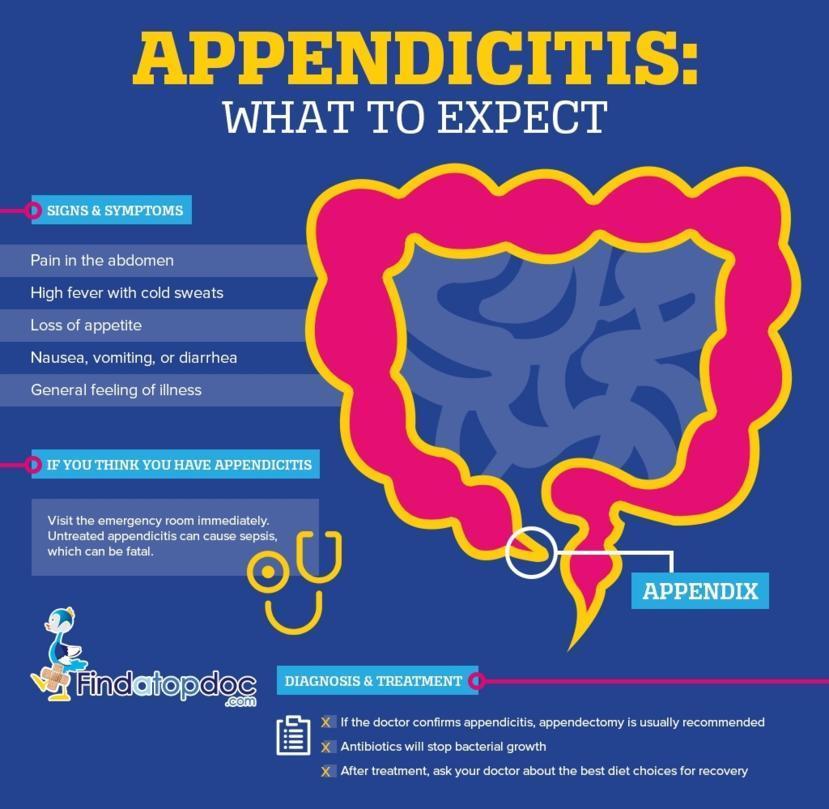Understanding Appendicitis in Children

Appendicitis is a serious condition that can affect both men and women at any point in life. However, it has been found that children and toddlers account for the majority of deaths caused by it. There could be several reasons behind this: The foremost is that adults can easily recognize and express the problems they are experiencing, and based on that, seek the doctor’s advice immediately. On the other hand, the innocent children are unable to explain their problems clearly.
According to the Society of American Gastrointestinal and Endoscopic Surgeons (SAGES), around 70,000 children in the United States suffer from appendicitis every year this condition is more prevalent in boys than girls.
Although appendicitis can be treated by medications or surgery without any complication, delayed treatment can lead to some. If the appendix bursts, the bacteria are released into the abdominal cavity, which can cause severe infection. As per the Cleveland Clinic, around 20-30% of children experience a ruptured appendix, which leads to life-threatening situations.
Symptoms of Appendicitis in Children
It’s difficult to identify all the signs and symptoms of appendicitis in children as they are unable to describe them. However, a pain near the belly button of your child is a usual symptom of this condition. Another common symptom observed in young children is the ‘rebound’ tenderness or the pain that occurs when pressure is removed suddenly from the lower right abdomen. Coupled with these symptoms, an elevated white blood cell count indicating the presence of infection in the body is caused to suspect appendicitis in young children.
According to Cincinnati Children’s Hospital, in most of the cases appendicitis affects children aged between 8 and 16. However, children below 5 years of age are also vulnerable to this condition. The abdominal pain is more noticeable while moving, sneezing, coughing, or touching the abdomen.
Some other symptoms are:
- Increased heart rate
- Frequent urination
- Pain while urinating
- Mild fever
- Poor appetite
- Vomiting
- Stomach pain, especially in the lower right abdomen
As with adults, children being transported to the hospital may complain of stomach pains if the ride is bumpy or jerky and this could be a positive indication of appendicitis.
Children less than four years of age are more susceptible to rupture of the appendix. This is because they display fewer classic symptoms, causing a delay in diagnosis and treatment. Statistics indicate up to eighty percent of kids in this age group, present with a ruptured appendix.
When to Call the Doctor?
If your child experiences any of the above symptoms, it is wise to seek a doctor’s advice immediately.If the child’s appendicitis is not diagnosed within 48 hours, the appendix may rupture, which can be lethal.
During the visit, your doctor will ask you some questions about signs and symptoms you are observing in your child. He may also perform imaging tests, like CT scan or ultrasound to confirm the condition. He may also take blood and urine tests to identify the other conditions.
Treatments for Appendicitis
Surgical removal is the standard treatment for curing appendicitis. If the appendix hasn’t ruptured, antibiotics will be given, and then the surgery will be performed. On the other hand, if the appendix has already burst, surgery is required immediately, which also involves irrigation of the peritoneal cavity. This ensures the bacteria present inside the appendix doesn’t move out to infect other organs. Children whose appendices have burst often have to stay longer at the hospital to receive IV antibiotics.
Appendix removal by surgery can be by one of the two methods outlined below. The team of doctors will deliberate and decide which will be the best option for your child.
1. Laparoscopic Appendectomy or keyhole surgery
This involves the use of a laparoscope – a thin, tiny tube with a video camera and light that is inserted into the abdominal cavity through incisions. This will help the surgeon view the appendix on the TV monitor and remove the infected appendix with the aid of other surgical instruments inserted through other incisions. All incisions are then sutured. Due to the small size of the incisions and minimal loss of blood, the patient can recover quickly with less scarring. The surgery, however, may be expensive.
2. Open Appendectomy or Traditional Surgery
In the event of a ruptured appendix, open surgery or appendectomy is the preferred mode of treatment. It involves the surgeon making an incision in the abdomen and removing the infected appendix from the intestine and suturing the incision. This procedure is preferred in acute cases as a larger incision can be made to clean the abdominal cavity.
Surgery often brings with it alarming concerns for parents. It is important not to be overwhelmed and clarify any concerns you may have even if it means asking repeatedly.
Preparing your Child
While you won’t get much time to prepare your child for the surgery, help them as much as possible through sound conversation. Tell them that it’s just a minor surgery, and they will be extremely fine after that. Don’t make anything sound scary. Explain that the treatment will be painless because the doctor will put them to sleep, but also tell them that they will be awake after some time. This will help them feel better, even after the surgery.
After the surgery
Post surgery, your child will be kept in the recovery room until they wake up. On waking, they will be taken to the ward and frequently monitored by nursing staff. Fluid and antibiotic medication will be given to the child through IV lines. The surgeon will also discuss the operation with you during this time. You will be given instructions regarding care and feeding of the child which must be strictly adhered to. The duration of stay depends on upon the nature of the case.
On discharge, the child may be required to rest and stay away from physical activity, but eat a regular diet. Complete recovery involves following instructions carefully to ensure your child is up and about at the earliest.












